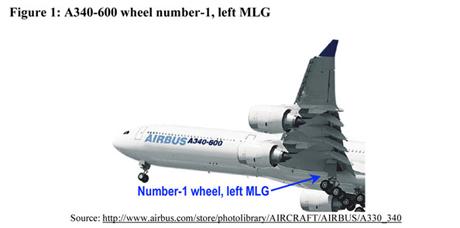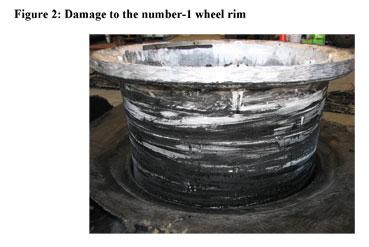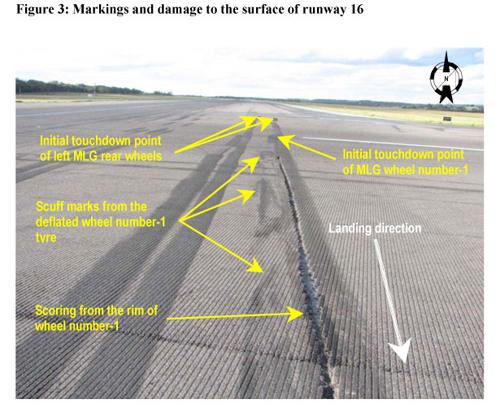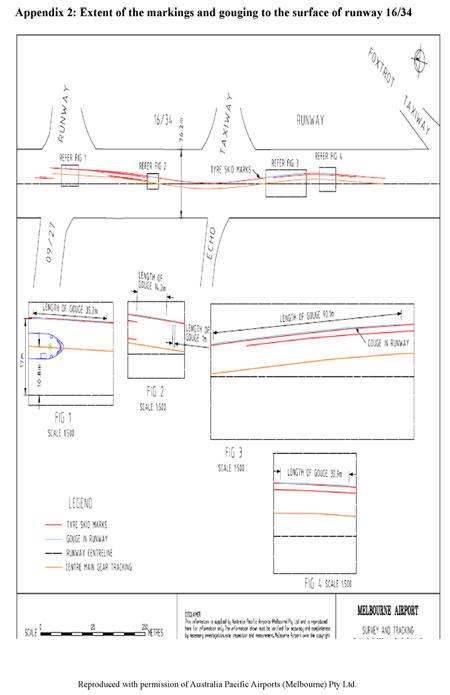Interim Factual report released 8 December 2005
At 1200 Eastern Standard Time (EST) on 26 October 2005, the outboard bead heel of the number-1 wheel tyre on the left main landing gear (MLG) of an Airbus A340-642 aircraft, registered HS-TNA, separated from the outboard rim of the wheel assembly during a landing on runway 16 at Melbourne International Airport, Victoria. The landing was conducted during strong crosswind conditions. The aircraft was on a scheduled passenger service from Bangkok, Thailand, with a crew of 19 and 247 passengers. The copilot was the handling pilot for the flight. There were no reported injuries to any of the aircraft occupants.
The number 1 wheel tyre deflated immediately after the bead heel separated from the wheel rim. The tyre then partially disintegrated during the remainder of the landing roll, and the tyre tread detached from the tyre casing (see Appendix 1).
Contact with the runway surface scored and scratched the outboard rim of the number 1 wheel assembly after the tyre deflated (see Figure 2).
Fragments of rubber dislodged from the disintegrating tyre resulted in some minor skin damage to the underside of the left wing and the left underside of the fuselage near the left MLG. Rubber fragments also broke off a small portion of the left MLG fairing door and dislodged a small inspection panel on the inboard side of the number 2 engine pylon. The disintegrating tyre also damaged a hydraulic brake line on the left MLG. The heat from the rear left MLG inboard wheel-brake assembly ignited hydraulic fluid, which leaked from the damaged brake line. The airport rescue and fire fighting service rapidly extinguished the fire.
The number 1 wheel rim damaged the surface of runway 16 after the tyre separated from the rim (see Figure 3). Appendix 2 depicts the extent of the markings and gouging to the surface of runway 16/34 as a result of the occurrence.
The Bureau of Meteorology weather radar data indicated that a cold front passed through Melbourne International Airport at about 1130. The 0200 Coordinated Universal Time (1200 EST) aerodrome routine meteorological report for Melbourne Airport included information that the wind direction and speed were 260 degrees true (T) at 23 kts, gusting to 29 kts. Melbourne Airport automatic terminal information service 'Yankee', issued at 1130, included information that the wind direction and speed were 230 to 280 degrees magnetic (M) at 18 to 30 kts, with a maximum crosswind of 14 kts.
The preliminary solid state flight data recorder (SSFDR) parameters examined by the Australian Transport Safety Bureau (ATSB) included:
- wind speed (kts) and direction (degrees T)
- radar altimeter (RALT, providing absolute altitude in feet above ground level)
- aircraft heading (degrees M)
- aircraft roll (degrees)
- aircraft landing gear AIR/GROUND status
- vertical and lateral accelerometer 'g' loadings.
The data revealed that the wind direction during the landing approach from 850 ft RALT was about 250 degrees T, allowing for some minor variations. Wind speed from between 850 ft and 400 ft RALT was about 22 kts, with a maximum 27 kts occurring at 500 ft RALT. From 400 ft RALT, the wind speed reduced to about 18 kts. About 6 seconds before touchdown, the wind speed began to increase and reached a peak of 40 kts about a 1⁄2 second before the right MLG parameter transitioned from AIR to GROUND.
The aircraft's heading remained relatively constant between 166 and 168 degrees M from 850 ft RALT, then increased to 175 degrees M, coincident with the wind gust encountered just before touchdown. The aircraft touched down with 15 degrees right yaw ('crab'), on a heading of 175 degrees M, and rolled in a 5-degree right wing low attitude.
The right MLG parameter was the first to transition from AIR to GROUND at touchdown, followed by the left MLG, then the centre MLG. The centre MLG parameter then transitioned back from GROUND to AIR, followed by the right MLG, indicating a 'bounced' landing. The right MLG parameter transitioned back to GROUND 1⁄2 second later. The left MLG parameter remained in the GROUND parameter after the initial touchdown.
Touchdown vertical 'g' loading was about 1.6 'g', and lateral 'g' loading was about 0.4 'g' to the left, indicating that the aircraft was in a right sideslip.
The investigation is continuing and will further examine recorded flight and cockpit voice data to better understand the circumstances leading up to the occurrence.
Recorded data covering environmental conditions are also being examined to assess any effect on the aircraft.
Appendix 1
Appendix 2







